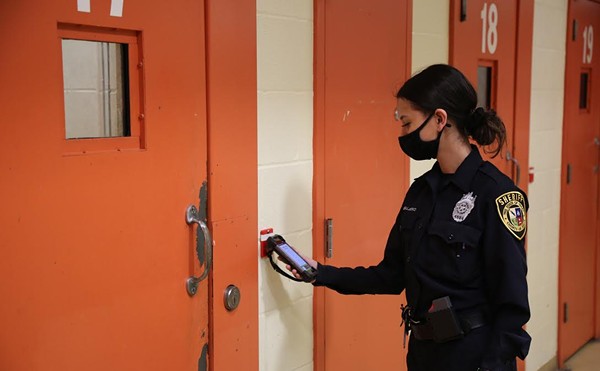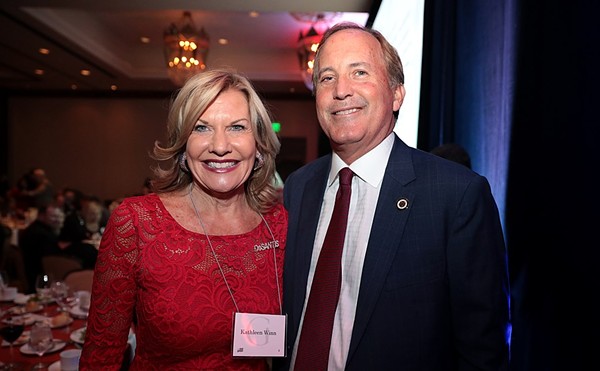Harriss recalls the men stalking pockmarked river beds with machetes, slapping at the few fish huddled in the remaining pockets of water. The Harriss family was rescued when the company boss ordered them to cut shop and move to Florida. Not everyone was as fortunate.
“There were many people, my friends, that had come from Mexico to work on the farm that didn’t have that opportunity,” Harriss said. “It was just a period where a lot of people were really desperate ... I don’t know what happened to them or where they went.”
Perhaps because Harriss lived through climate uncertainty as a child, he is startlingly clear-eyed about the dust-storm gathering today. President and CEO of the Houston Advanced Research Center in the Woodlands and a senior scientist at the National Center for Atmospheric Research, Harriss writes the prescriptive chapter in a forthcoming book that details the devastation Global Warming is bringing to South Texas. `See sidebar, page 10.` The Changing Climate of South Texas, 1900-2100, to be published in late September, paints a bleak portrait of what we can expect from the next 93 years. The dire weather forecast, divided into 10 topical chapters, proposes that the already “problematic” climate of South Texas — an unpredictable zone bridging the moist East with the great deserts of the West, a more seasonal North with the frostless South — is about to become much more unpredictable and unmanageable.
Eleven of the past 12 years already rank as the hottest on record and a 2007 report by the Intergovernmental Panel on Climate Change connects these changes to human behavior to the closest degree yet. Now the collective research by some of A&M’s top scientists — the first of its kind to focus on South Texas — is yet one more confirmation that the state’s most ecologically delicate region won’t escape the effects of Global Warming unscathed.
“Here we have a region that’s climate-vulnerable,” says Jim Norwine, a regents professor in physics at Texas A&M-Kingsville and the lead editor of The Changing Climate of South Texas. “These kinds of subtropical, semi-arid regions are on the edge already. It’s not like you have a lot of fudge factor.”
While it’s unlikely, rainfall levels may stay roughly the same as they have been, but they will probably be delivered in bursts of violence, followed by intense flooding, separated by periods of drought. What water does reach the region will be lost to evaporation thanks to an anticipated 7-degree spike in average temperatures, researchers found. Freshwater supplies and crucial Gulf breeding habitats will be swept over by rising sea levels, which could climb as high as 20 feet. In essence, it will be as if you lifted modern-day South Texas from its political and geographic boundaries, moved it 100 miles southwest into Coahuila, Mexico, and turned on the fury.
Which is not to say that there isn’t some uncertainty about these dire predictions. Most of the researchers interviewed were quick to say that things may not turn out as bad as they believe. Though considering they employed the more conservative data sets available to create the forecasts, there is also a 50-percent chance things will be worse.
| Global Warming for Dummies
Despite the confusion sometimes generated by less-than-scientifically-sincere debates on the topic, Global Warming is a fairly simple process to explain. It is the recorded, observed, and projected continued warming of the Earth due to a build-up of heat-trapping gases in the planet’s upper atmosphere. A majority of scientists attribute this warming to the vast increase in carbon dioxide and other “greenhouse gases” entering the atmosphere from human industrial activity. Greenhouse gases like CO2, water vapor, methane, and nitrous oxide help regulate the Earth’s climate by keeping the Sun’s solar energy from flying back into space too quickly, graciously making life on the planet possible. However, the spike in gases these past 200 years is trapping too much heat inside the planet’s climate systems, creating the current warming. “Everyone criticizes Al Gore and his little movie, but the data is there,” said Kim Jones, chair of environmental engineering at Texas A&M-Kingsville. “I mean, you could go into your greenhouse and do some of these experiments.” The amount of CO2 being released into the atmosphere has increased by about 35 percent since the dawn of the industrial area. CO2 is the longest-lived and most important human-produced greenhouse gas. A vocal minority of scientists continue to refute the contribution of human industry. However, one of the principal guilt-free alternative theories, that Global Warming is due to increased solar activity, was debunked in a British study this month that found while solar output decreased over the past 20 years, the Earth’s climate has continued to cook. So much for trashing golden Helios. |
Global Warming is not a handgun expressing itself on campus. Neither is it a highway rollover. Or a celebrity feud. Global Warming is cause-and-effect on steroids: formed from innumerable actions and birthing infinite mutations, often in seeming conflict. Crippling drought follows major flooding in one newscast; heat waves and freak blizzards the next. Given its complexity, Global Warming doesn’t make an easy news blurb. There are, however, a reliable stable of images conveying the facts of our warming planet — the hurricane’s whorl, shriveled glaciers, and dark, epiphanous smokestacks. Add to these a blistering Rio Grande Valley of wheat, cotton, and dust where defining citrus groves once stood.
That’s another of the likely outcomes of Global Warming on South Texas, according to Kim Jones, chair of environmental engineering at Texas A&M-Kingsville. Though careful not to overstate his case, Jones offers: “It’s hard to say anything good about this report ... The trends aren’t promising.” He said the teams were shocked when they came upon the 7-degree figure.
“When we first looked at this, we thought, ‘Wow. This can’t be right.’” Then the IPCC released its 2007 findings, which suggests a global rise between 3.1 and 7.2 degrees Fahrenheit — with an outside possibly of 11.2 degrees by century’s end. Not only will citrus crops be abandoned, but flood irrigation will be a thing of the past. Drip and micro-spray irrigation will become standard and more heated fights for poorer-quality water will ensue. Effluent will have its day.
Then there is the sheer mind-bending heat, sucking water out of the earth beyond the earth’s capacity to replenish it. “All things being equal, if we kept all those fields in production we’re going to need a 60-percent increase in water supply,” Jones said. Currently, about 22 inches of water is baked off South Texas fields each year. A 7-degree temperature jolt would result in about 90 inches being lost annually. “It’s just going to cook it off,” he said. Operations that don’t switch from water-intensive crops will likely sell out and move off. “It’s not doom, but it’s gonna be awfully hard on those guys.”
From the start, Global Warming has been a dull knife sunk deep into the heart of American politics, dividing rudely between the red and the blue. A poll by the Pew Research Center for the People and the Press earlier this year found that while just over half of self-identified conservative Republicans believe the Earth is getting warmer, 92 percent of liberal Democrats agree with the warming assessment. However, a growing pool of purple has gathered around the blade as increasing numbers of conservatives have come to believe in both the impact of thermostats and the surge inside their thermometers.
The Changing Climate, penned by Aggies, will likely grow that purple pool in Texas. After all, these are kin to the agricultural extension agents already linked, county by county, to the growers across the state. It’s hard to harbor a conspiracy theory about the guy in Justin boots checking your boll-weevil traps.
From the way things look, we’ll be needing that advice for a few more centuries. While the Aggie report tops off at 2100, the IPCC report states that the weather patterns unleashed by human-caused Global Warming will be with us for “more than a millennium.”
| A prescription for the coming age of catastrophe
Texas has a penchant for disaster. In fact, we have the dubious distinction of posting the highest disaster losses and greatest number of federal emergencies in the nation. Given this history of natural violence, the unaddressed issues of poverty and poor social planning have left South Texas a “catastrophe waiting to happen,” Bob Harriss writes in the final chapter of The Changing Climate of South Texas: 2000-2100. However, the solutions proffered for our impending climate chaos veer from the traditional carbon contempt of the environmental movement’s vanguard. Harriss’s prescription doesn’t revolve around planting ginormous windmills, dismantling coal plants, or broadening the market in climate “indulgences.” Instead, quoting Heidegger, Rilke, and William Blake, Harriss focuses on the need for social restructuring to empower our poorest communities to better care for themselves when the skies shut up their rain and the oceans rise against us. “We know that hurricanes, droughts, heat waves, sea-level rise, and other weather and climate extremes will intersect with our social vulnerability and fragile ecologies to create future megadisasters,” he writes. “Sadly, leaders and institutions at all levels of governance are underestimating the growing fragility of our region.” First, Harriss argues, we must reduce the vulnerability of our poorest residents and neighbors on both sides of the border. (It’s a “terrible time” for putting up walls, he says with a subdued passion). We must recognize that much of the “unfettered growth” along the border is putting more lives and property at risk from drought, flood, and storm. Bridges, dams, and roads across the region need to be repaired. And special attention should be paid to our unincorporated colonias — possibly the most vulnerable communities in the nation. Minds need to be changed, too, through a “fundamental restructuring” of the state’s educational system to inspire “confidence in youth that they can successfully solve the challenges of creating better futures.” South Texas communities will need increased economic prosperity and resilience to weather the storms ahead, he writes. Stronger regional policies and emergency training and a basic respect for our “natural systems” — the very ones we have thrown out of whack with our industrial mayhem — are prerequisites to survival. “One certain conclusion from our assessment,” writes Harriss, “is that a ‘business as usual’ approach to the future will endanger the livelihoods and lives of all 21st Century South Texans.” |

















